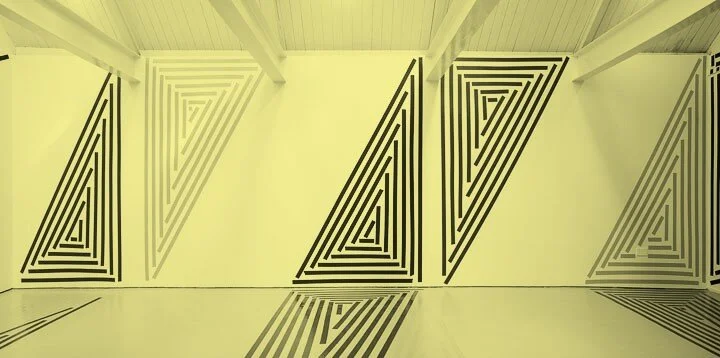#113 James Epps, Just like that
2 - 21 September
James Epps was born 1988. He studied at Norwich University College of the Arts. James currently lives and works in Norwich.
A conversation between James Epps and Jessica Mendham.
Jessica Mendham: Could you tell me about the use of colour in the work? Coloured gaffer tape is unusual. How did you decide on the colours and how many to include?
James Epps: The choice to use gaffer tape came first really, then it was a case of deciding if I wanted to use colour and exactly how this might work. I had been interested in the idea of making work in the studio that would cover a wall and using tape was a very effective way of creating something across from one point to another. I find it much easier to draw a line across a wall using gaffer tape, compared, for arguments sake, to paint, because you can move a line made by gaffer tape very easily, or shorten it in a way you can’t if you paint or draw a similar kind of line. I could have used a different kind of tape, but gaffer tape is quite strong, so it makes it easier to use than sellotape or masking tape as a comparison.
Once I knew I wanted to use gaffer tape I was aware I could use different colours, although there are obviously more limitations on the choice of colours with a material like gaffer tape compared to paint. Using the different colour tapes across the space meant that you can make more connections across the gallery, and as a way to differentiate the various sections compared to if it had all been done with black gaffer tape. I could have used different colours to those I have here, but from what was available these three colours made sense to me in terms of deciding on a sequence for the space, however this selection is just one possibility rather than being definitive.
JM: So is the use of the tape important because of what it is, or is it because of what you can do with it? You have spoken previously about using the qualities a material has inherently, is this something which applies to the work at OUTPOST?
JE: That’s it really, it’s a case of what the material can do and how you can use it. For this show at OUTPOST I wanted to make one work that would go across the floor and walls and for me gaffer tape was an obvious choice of material that would be able to do this. It doesn’t need anything else to attach it to the different surfaces and it’s quite easy to do different things with. Often when I use materials it makes sense to use things that aren’t too precious and to use materials that offer possibilities.
JM: Does this practicality of allowing you to do something that the tape has extend to the use of the space or the pattern? Why triangles?
JE: It goes back to wanting to make something across the whole space again, and I started this by going from one corner to another and continuing from there and acknowledging what’s already in the space like the I-beams and the door. I could have gone about it in another way, but that is what I did and it lead to this triangular pattern. However none of the lines are perfectly straight and there aren’t any corners to the shapes, so I don’t think they are really triangles. They look like triangles, and this word fits to describe what’s there; it’s a bit of a gap between the word and the thing, but it still works.
JM: The gap between the word that describes and the thing itself is an interesting thought. I’m interested to know if you have noticed gaps between physicality and language cropping up anywhere else? I’m thinking of how the work ‘fills’ the gallery and the gaps between language and the thing there.
JE: That’s true. It feels like the tape is all over the gallery, but there is much more of the gallery where there isn’t any tape. In one sense the gallery is full, in another way it’s empty. It’s a similar thing with colour, where you get tape described as being yellow, but perhaps in a particular light it doesn’t really look that yellow at all. You could have a different object that someone might also call yellow, but next to each other they can still look to be two very different colours - although they are both still yellow. As you say it’s interesting, but I don’t think it’s imperative to the work itself; everyone is going to have their own experience from a work like this.








